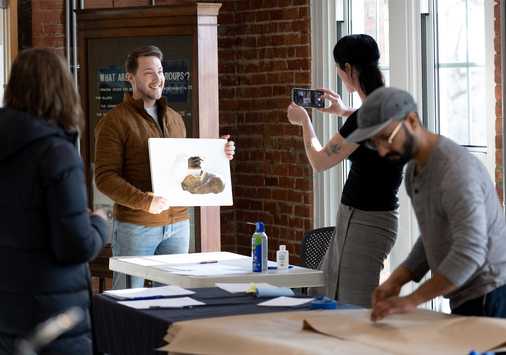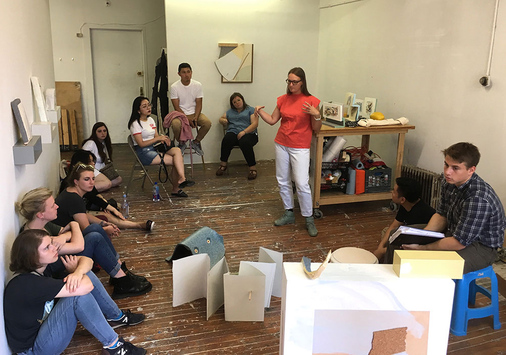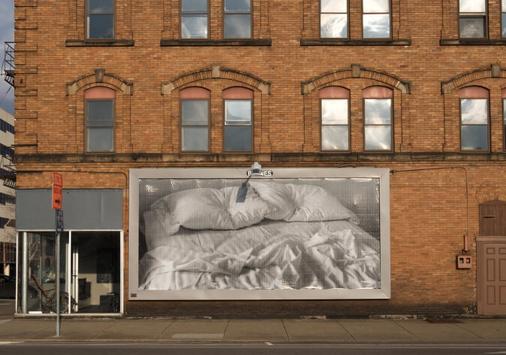Degree Requirements
Information presented from the 2024 - 2025 Academic Catalog.
The Visual Arts major was introduced in 2024 as a revised version of the former Studio Art major. Students who matriculated prior to the Fall of 2024 may choose to graduate with a Studio Art degree. Any Studio Art major who matriculated prior to Fall of 2024 must work closely with the department to ensure that they are meeting all requirements appropriately.
Departmental Guidelines
In Visual Arts we foster independent and creative thought, emphasizing art-making as a means of thinking about not only oneself, but our relationship to the world of ideas from multiple perspectives. We offer two degree programs in Visual Arts, a bachelor of arts (BA) and a bachelor of fine arts (BFA). Both degree programs emphasize technical skills and critical thinking, interdisciplinary work, collaboration and community. We encourage the fluidity of learning and see art as a bridge to all areas of study and research. The BA and the BFA prepare students in different ways for a variety of post-graduate pursuits, be it graduate school or professional endeavors in art and related fields. Students who plan to major in Visual Arts are strongly advised to seek an advisor in Visual Arts at the time of their decision to major. Visual Arts majors are required to take a series of core courses and students need to work closely with advisors to complete these core courses by end of the first semester in their junior year. Students should expect to work two hours per week outside of class for each credit hour of a course. For students to whom off campus study is an option, we transfer up to 4 courses from an off-campus study experience towards the major, pending approval from the Chair.
Mission Statement
Denison Visual Arts students develop an artistic language by acquiring technical and critical capabilities that allow them to appreciate and contextualize their own art practice within a contemporary artistic, social, historical and cultural environment. The curricular structure of our program requires our students to develop a knowledge of multiple disciplines; photography, printmaking, sculpture, ceramics, painting and digital technologies. The program emphasizes the need for agility of thinking and making, while also allowing for a depth of exploration in areas that are of interest to the student or their practice. In emphasizing a commitment to thinking and making in plurality of material and thought, we seek to remove the silo mentality of separate spheres. Our students are taught to consider art-making as a means to not only think within and of themselves, but also to contextualize themselves and their work – to place themselves in a historical and contemporary trajectory and take responsibility for being a part of a complex world of ideas and perspectives.
Creative Process: Students are exposed to contemporary and historical visual practices through a combination of foundation and higher level courses that demonstrate the fluidity of learning Visual Arts in a liberal arts context. Demonstrating the breadth and depth of our curriculum, students are expected to initiate and bring to realization creative works in a variety of mediums.
Thinking as an Artist: In classes across the curriculum, students are encouraged to see art making as an education in risk-taking, problem solving, collaboration, with the ability to embrace ambiguity with a critical awareness of the world at large. A central learning goal in all our classes is to establish independent artistic thinkers. This goal is addressed in introductory classes, which include both research and final projects for students to realize by working independently. This speaks to the goal of establishing independent creative work.
Critical Inquiry: Students become creative thinkers who are able to engage in understanding of critical trends and contemporary artistic discourse in their own work, and as participants in the community of the classroom or program.
Visual Literacy: Our students are expected to articulate and understand complex ideas through art and art-making as well as through critique settings, written artist statements and oral presentations. Students develop a body of work through a process of self-actualization that includes critiques, exhibitions, written and oral defense. Our program seeks to ground students’ creative development in larger social, cultural or political discourse.
Active Citizen: We strive to create a learning community to not only nurture creative artistic growth but also foster collaborative spirit, awareness of our diverse complex world and ultimately, encourage empathy for others within our students.
Students who matriculated prior to the Fall of 2024 may choose to graduate with a Studio Art degree. Students who matriculated after 2024 please see the Visual Arts degree requirements. Former Studio Art courses now carry the Visual Arts departmental designation. Any Studio Art major who matriculated prior to Fall of 2024 must work closely with the department to ensure that they are meeting all requirements appropriately.
Visual Arts Major (B.A.)
Our BA students are encouraged to connect their Visual Arts major with the curriculum of the college to realize individual approaches to Visual Arts that are interwoven with science, social science, humanities and/or other fine arts disciplines. A total of 46 credit hours are required, with 12 courses coming from Visual Arts and one course from Art History and Visual Culture.
- 12 courses (46 Credit Hours) total: 12 Visual Arts Courses
- 3 core courses to be completed by the end of first semester Junior Year
- ARTS 101 - Visual Arts: Making and Meaning.
- one 2D course (Drawing, Painting, Printmaking, Photography)
- one 3D course (Ceramics, Sculpture, Installation, Fibers)
- Electives
Two 200 level Visual Arts electives.
Two 300 level Visual Arts electives.
- One semester of Junior Practicum.
- Senior Year:
- One Art History and Visual Culture elective.
- All Visual Arts majors (B.A. and B.F.A.) are required to participate in the group Senior Exhibition and are required to give a Gallery Talk in conjunction with the Senior Exhibition.
- ARTS 301 Creative-in-Residence - two semesters (Junior and Senior year).
- At least one art/design-related internship (to be approved by the Dept. Chair).
Visual Arts Major (B.F.A.)
Students pursuing a BFA degree should discuss their intentions with a member of the Visual Arts faculty as soon as possible. Students are required to apply to the BFA program in the first semester of their Junior year by presenting artwork made at Denison in an exhibition with fellow applicants. Prospective BFA candidates will then be required to meet at the exhibition with the Visual Arts faculty for a discussion of their work and their reasons for pursuing the BFA degree. Upon acceptance into the BFA program, the department will notify the Registrar. BFA students are also subject to periodic review of their studio work by the Visual Arts faculty. A total of 70 credit hours are required, with a minimum of seventeen courses coming from Visual Arts and two courses from Art History and Visual Culture. Students may then choose one more elective from either Visual Arts, Art History and Visual Culture or PHIL 269 - Philosophy of the Arts: Aesthetics.
17 Courses Total:
- Five core courses to be completed by the end of 1st semester Junior Year:
- ARTS 101 - Visual Arts: Making and Meaning,
- ARTS 110 - Introduction to Drawing (or ARTS 170 - Introduction to Drawing for Majors)
- one 2D course (Drawing, Painting, Printmaking)
- one 3D course (Ceramics, Sculpture, Installation, Fibers)
- one time-based course (such as Photography, Video, Performance Art, Animation or a Web-Based Visual Arts Course).
- One semester of Junior Practicum.
- five electives:
- two 200 level studio electives,
- one 300-level studio elective or independent study
- and one more 200 or 300-level elective or directed study.
- The final elective may come from either Studio Art, AHVC or PHIL 269 - Philosophy of the Arts: Aesthetics
- NOTE: ARTS 110 - Introduction to Drawing / ARTS 170 - Introduction to Drawing for Majors cannot be used to fulfill the 2D course requirement for the BFA.
- Senior Year:
- ARTS 401 - Visual Arts Practicum plus ARTS 451 - Senior Research – in the fall semester Senior year.
- ARTS 402 - Visual Arts Practicum II plus ARTS 452 - Senior Research – in the spring semester, Senior year.
- (Senior BFA Visual Arts majors are required to take ARTS 401 - Visual Arts Practicum during the fall of the Senior year and ARTS 402 - Visual Arts Practicum II in conjunction with one year of senior research that will culminate in a solo or 2-person exhibition and an oral defense with a committee of 3 faculty "readers"). BFA candidates are required to meet with each committee member at least twice over the course of their Senior year before the final defense, which takes place in the exhibition.
- Create a BFA solo exhibition. Write a thesis in conjunction with the solo exhibition. Defend work to faculty panel. Participate in the group Senior Exhibition and give a gallery talk in conjunction with Senior Show.
- ARTS 301 Creative-in-Residence - two semesters (Junior and Senior year).
- At least one art/design-related internship (to be approved by the Dept. Chair).
- Two Art History and Visual Culture courses should be determined in consultation with the student’s advisor.
- BFA students follow the college-wide General Education course requirements.
- All Visual Arts majors (B.A. and B.F.A.) are required to participate in the group Senior Exhibition and are required to give a Gallery Talk in conjunction with their BFA solo Senior Exhibition.
Visual Arts Minor
A minimum of six courses (five in Visual Arts and one in Art History and Visual Culture) should be taken as follows:
- ARTS 101 - Visual Arts: Making and Meaning,
- four elective Visual Arts courses (one elective must be a 200-level Studio course),
- and one AHVC course
- Participate in the Minor Exhibition
- Give a gallery talk in conjunction with the Senior Minor's Exhibition














